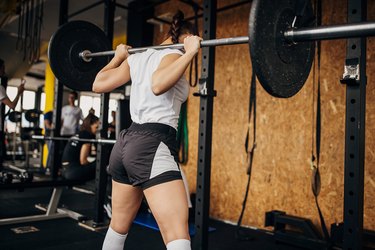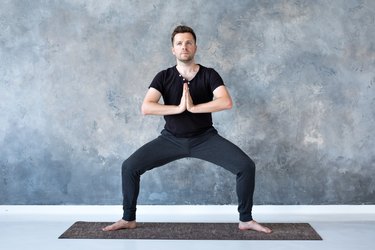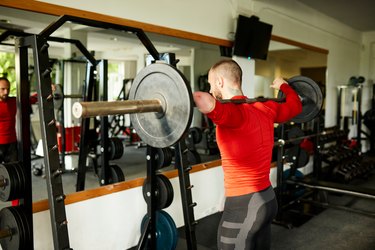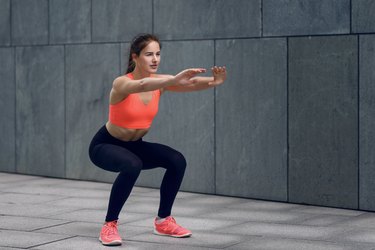

If squats are at the top of the leg-building pyramid (and they are), barbell squats are the tippy top. They do everything the best squat variations do — and more. They build next-level lower-body strength, core stability and even upper-body mobility. But great gains come with great responsibility. Here's everything you need to know to do BB squats (of all kinds!) with safe and effective form.
- What is a barbell squat? It's a squat variation that involves pushing your hips back and bending your knees to lower as far as comfortable, then standing back up — all while holding a barbell.
- What muscles does the barbell back squat work? It primarily targets your quads, but it also works your glutes, hamstrings and calves. Your core also gets a great workout by balancing the weight.
- Who can do BB squats? Once you've mastered the air squat and dumbbell squats, you've got the green light to begin BB squats. The exact type that's best for you depends on your individual mobility and joint health. Read below for more details and, when in doubt, talk to a physical therapist.
Video of the Day
How to Do the Barbell Squat With Perfect Form
Often, when people talk about BB squats, what they're really talking about is barbell back squats. So, let's start there. But don't worry, there are lots of other ways to squat with a barbell, and we'll cover them all.
Barbell Back Squat
- Set up in a rack with your feet about shoulder-width apart, and the bar resting across your upper back on the fleshy muscle around your neck. Grab the bar with an overhand grip (palms facing forward).
- Unrack the bar carefully and set your feet at a comfortable stance. Your feet can be slightly turned out or facing straight ahead. If you don’t know where you’re comfortable, play with your foot placement.
- Brace your core and upper back. Maintain a tight torso throughout the movement with a small, natural arch in your low back.
- Keeping your weight in your heels, push your hips back and bend your knees to lower as far as comfortable or until your thighs are parallel to the floor.
- Press your heels into the ground to stand back up.
Tip
If the barbell is resting on your neck versus your back, you risk pain and injury. Instead, make sure the bar is resting on your traps — aka your shrugging muscles. You can position the bar higher or lower across your back as feels comfortable to you.
Watch the Full Tutorial
How Low Should You Go?
There's a lot of debate about deep vs. regular squats, but in the end, the best depth is the one that you can do comfortably while keeping good form.
If it's comfortable on your knees and ankles, you can lower until your thighs are at or below parallel with the floor for more glute activation. But if a quarter or half squat feels better on your joints, you get the greatest benefits there.
The 5 Best Barbell Squat Variations
Barbells are one of the most versatile training tools, and there are many ways you can do BB squats. Here are some of the best variations to help you get more creative with the barbell.
Move 1: Heels-Elevated Barbell Squat
Elevating your heels on weight plates makes it easier to lower further, and is the way to go if you accidentally rock onto your toes during your reps. If you're not into heel-elevated squats, you can get the same effect by wearing weightlifting shoes with built-in heel lifts.
- Set up in a rack with your feet about shoulder-width apart with your heels on top of small weight plates — around 2.5-pound plates. Place the bar on your trapezius muscles — not on your neck. Grab the bar with an overhand grip (palms facing forward).
- Unrack the bar and set your feet at a comfortable stance. Your feet can be slightly turned out or facing straight ahead. If you don’t know where you’re comfortable, play with your foot placement with some light warm-up sets.
- Brace your core and upper back. Maintain a tight torso throughout the movement with a small, natural arch in your low back.
- Keeping your weight in your heels, push your hips back and bend your knees to lower as far as comfortable or until your thighs are parallel to the floor.
- Press your heels into the ground to stand back up.
Move 2: Barbell Front Squat
If you have trouble or discomfort with the positioning of back-loaded exercises, give this one a try.
This variation puts more stress on your quads and knees as opposed to your glutes and hips (like the back squat). If you're really wanting to focus on your thigh strength, that's a big plus. It also lets you keep a more upright torso.
Tip: Use lighter weights with front squats than you do back ones.
- Set up in a rack with your feet about shoulder-width apart and place the bar in front of your shoulders. As you prepare to unrack the bar, it should be barely touching your neck in the front.
- Unrack the bar and set your feet at a comfortable stance. Your feet can be slightly turned out or facing straight ahead. If you don’t know where you’re comfortable, play with your foot placement with some light warm-up sets.
- Brace your core and upper back. Maintain a tight torso throughout the movement with a small, natural arch in your low back.
- Keeping your weight in your heels, push your hips back and bend your knees to lower as far as comfortable or until your thighs are parallel to the floor.
- Press your heels into the ground to stand back up.
Tip
You can hold the bar in front of your shoulders a couple different ways. The video above shows the “catch” grip (keeping your elbows forward and palms facing up). You can also try crossing your arms in front of you so that your palms are pressing into the bar. Your right hand is on your left shoulder and your left hand is on your right shoulder.
Move 3: Zercher Squat
This BB squat variation allows you to improve the depth of your squat while keeping your torso upright and activating your core. It also engages your core, shoulders and biceps to help hold the weight in place. Expect your abs to be sore the next day.
- Set up in a rack with your feet about shoulder-width apart and the bar at waist height. Bend your knees and place the bar in the crooks of your elbows — you may want to place a pad between your elbows and the bar.
- Stand up to unrack the bar and set your feet at a comfortable stance. Your feet can be slightly turned out or facing straight ahead. If you don’t know where you’re comfortable, play with your foot placement with some light warm-up sets.
- Brace your core and upper back. Maintain a tight torso throughout the movement with a small, natural arch in your low back.
- Keeping your weight in your heels, push your hips back and bend your knees to lower as far as comfortable or until your thighs are parallel to the floor.
- Press your heels into the ground to stand back up.
Move 4: Barbell Hack Squat
Just like the Zercher squat, this variation helps you hinge your hips deeper in your squats and hones in on your posture, ensuring that your chest stays lifted and your torso upright as you lower and stand back up.
It's also a great version if you find holding a barbell across your back or shoulders to be uncomfortable.
- Hold a barbell at arm’s length behind your back with an overhand grip. Stand with your feet shoulder-width apart. You may want your heels elevated on plates as in the heels-up squat.
- Brace your core and upper back. Maintain a tight torso throughout the movement with a small, natural arch in your low back.
- Press your heels into the ground to stand back up.
Move 5: Overhead Squat
This is an extremely advanced move that will work your core, shoulders and arms more than other squat variations. It also requires more shoulder mobility. Use a lighter weight and keep your arms completely vertical throughout the lift — don't let the bar drift forward or backward.
- Hold a barbell overhead with an overhand grip about double your shoulder width.
- Set your feet at a comfortable stance. Your feet can be slightly turned out or facing straight ahead. If you don’t know where you’re comfortable, play with your foot placement with some light warm-up sets.
- Brace your core and upper back. Maintain a tight torso throughout the movement with a small, natural arch in your low back.
- Keeping your weight in your heels, push your hips back and bend your knees to lower as far as comfortable or until your thighs are parallel to the floor. The bar should stay overhead and completely vertical throughout the exercise.
- Press your heels into the ground to stand back up.
5 Barbell Squat Form Tips
Whatever BB squat variation you do, these are the most important pointers to keep in mind.
1. Take a Comfortable Stance
Normally, you want your feet just about shoulder-width apart.
But some people may feel comfortable going a bit wider or closer together. That's because your hip sockets and thigh bone (femur) shapes determine exactly how your hips can move during the exercise. Speaking of which, your right and left hips aren't mirror images, so you may need to set up with one foot a little more angled to the side than the other.
Whatever foot width and angle you choose, your knees should not cave in or bow out throughout the movement.
2. Keep Your Spine in One Long Line
You might have seen some fitness influencers or trainers on social media tipping their head back and looking at the sky while they squat — or popping their butt out like they're twerking — but you want to avoid this during your reps.
This can cause neck strain and compress your lower back, especially if you're not wearing a belt for lifting extra heavy weights. To avoid this, keep your spine in one long line by bracing your core and looking straight ahead or slightly down (at about a 20-degree angle).
3. Squeeze Your Shoulder Blades
Before you lower down, imagine you're bringing your shoulder blades together, and then tucking them into the back pockets of your jeans.
This will set your shoulders back and down to better brace your core (which includes your back!) and move more safely and effectively.
4. Keep Your Shins and Back Parallel
Throughout the exercise, your shin and back should be roughly parallel. When this happens, it means that you're successfully bending your hips and knees at the same time and speed — and not
If you're exercising next to a mirror, give yourself a little side-eye to make sure you created a 90-degree angle with your legs. Or, to reduce the risk of throwing off your form when you look sideways, record yourself on your phone.
5. Start Without Weight Plates
New to the barbell? The best barbell squats for beginners are light ones using just the bar. Remember: Most standard barbells weigh 45 pounds (some weigh 35), so even if you're using "just" the bar, you're still moving some serious weight.
Choose a weight that allows you to keep good form.
Tip
Once you start using weight plates, it's critical that you secure them with barbell clips!
5 Barbell Squat Benefits and Muscles Worked
1. They Build Strong Legs and Glutes
Sure, there are plenty of other exercises — like the hip thrust — that really target your glutes, but with proper barbell squat form, you're not just working your glutes — you train your entire lower body. In addition to your glutes, it strengthensargets your quads, hamstrings and calves.
The key to building leg muscle is prioritizing depth over weight, meaning you want to get low with your squats versus packing on the plates when you do a BB squat. (That said, never go deeper than is comfortable!)
A small October 2012 study in the Journal of Strength and Conditioning Research found that people who squatted deeper had greater quadriceps engagement than those who had shallower squats with more weight.
Do Barbell Squats Make Your Butt Bigger?
Although barbell hip thrusts are much more effective at activating your glutes than barbell back squats, they are still highly effective at strengthening your butt muscles.
Pro tip: Widening your stance slightly increases glute activation when back squatting, per an April 2012 review in the Journal of Strength and Conditioning Research.
2. They Can Improve Your Knee Health
Some people worry about barbell squats hurting their knees, but they can actually be good for your knees if you do them with good form. That's because they strengthen your quads and glutes, which help take the load off your knee joint.
Backloaded squats are also particularly good for people with knee issues because they strengthen your quads without putting as much stress on your knees. However, whatever variation you choose, master dumbbell and moderately loaded reps before progressing to a heavy barbell.
3. They Increase Sports Performance
Regular squats can help improve your vertical jump performance, which is why they're a must for wannabe dunkers and spikers.
For the greatest benefit on the court, drop it low. In a small December 2012 study in the Journal of Strength and Conditioning Research, people who performed full squats (lowering to parallel) twice per week for 10 weeks improved their vertical jump height significantly more than those who did quarter squats.
4. They Strengthen Your Core
Your core is more than just your abs: It's your entire torso, including your back.
One of the biggest barbell squat benefits is that it works your erector spinae muscles (muscles in the back of your torso responsible for spinal control) twice as much as isometric exercises like the plank, according to an October 2014 study in the Journal of Strength and Conditioning Research.
5. They Give You Endurance
If you want to go the distance with your runs or cycling mileage, it's a smart idea to hit the barbell squat rack.
Case in point: In a June 2008 study in Medicine & Science in Sports & Exercise, runners who performed 4 sets of 4 reps of barbell back squats for eight weeks improved their endurance and running economy (how much energy and oxygen needed to run) compared with runners who didn't squat.
More Great Squat Variations:
- Journal of Strength and Conditioning Research: "Muscle Activation in the Loaded Free Barbell Squat: A Brief Review"
- Journal of Strength and Conditioning Research: "Electromyographic and Kinetic Comparison of the Back Squat and Overhead Squat"
- Medicine & Science in Sports & Exercise: "Maximal Strength Training Improves Running Economy in Distance Runners"


